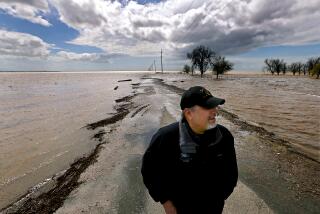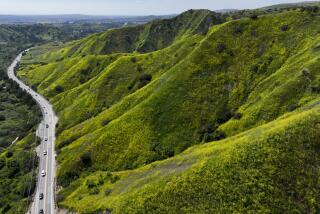Bill Altering Use of U.S. Water in State Stirs Sparks : Drought: Farmers blast, environmentalists praise Sen. Bradley’s plan, which is designed to increase supply to wildlife areas and cities.
- Share via
SACRAMENTO — U.S. Sen. Bill Bradley’s proposal for a radical redistribution of federal water--more for California cities and wildlife and less for agriculture--drew a range of responses Thursday as the measure faced its third public airing.
Agricultural interests attacked it. Environmentalists embraced it. Urban areas represented by the Metropolitan Water District, which has been trying to get along with both sides, took a neutral stand.
In the political arena, it was praised by Democrats and assailed by Republicans. It won a hearty endorsement from California’s Democratic senator, Alan Cranston, who is a co-sponsor, while Republican Sen. John Seymour recounted his strong opposition. Seymour has offered an alternative measure for dealing with the state’s water problems.
Meanwhile, Bradley, a New Jersey Democrat who has thrust himself into the midst of an enduring and explosive issue, took the criticism and the compliments mostly without comment. At the end of a four-hour hearing, Bradley announced that he was willing to consider some changes in his plan but would not back off the legislation.
As he had throughout the hearing, Bradley continued to warn that if California does not take steps, either through his legislation or other means, to repair the environmental damage caused by the Central Valley Project, it runs the risk of a “judicial takeover” of the giant water system.
With the operation of the project continuing to contribute to the decline of various fish and wildlife, Bradley said it was only a matter of time before federal jurists use the powers of the Endangered Species Act to step in and take control of the allocation of federal water in California.
“There are problems with doing nothing,” Bradley said, adding, “Would you rather have a federal judge in charge, directing the operation. . . . “
But the specter of a federal judge assuming the role of California water czar did little to slow criticism from agricultural interests who predicted that Bradley’s proposal would have a disastrous impact on the state’s multibillion-dollar farming enterprises.
Under the measure, farmers, who in the past have negotiated 40-year contracts for water from the Central Valley Project, would be restricted to one-year contracts unless they agreed to give up some of their water for distribution to fish and wildlife. Farmers could get longer contracts--up to 20 years--if they agreed to cut their water consumption by 10% to 20%.
To encourage transfers of water to needy urban areas, the bill would allow farmers to sell water outside their service areas but would impose a 25% tax on the sellers. Under current regulations, farmers who receive Central Valley Project water are not allowed to sell it for distribution beyond the boundaries of their water district.
The proposal would create a $30-million “restoration fund” to repair damage to wildlife habitat by imposing a surcharge on Central Valley Project water and power sales.
“This bill imposes Draconian terms and conditions on water sales contracts never seen before,” said state Sen. Ken Maddy (R-Fresno), who represents the farming areas that receive most of the project’s water. “California is not in a position to take on any more regulation from anywhere, be it Sacramento or Washington, D.C.”
Barry Brown, irrigation engineer for the Western Farm Credit Bank, predicted that the taxes and surcharges imposed by Bradley’s legislation would saddle farmers with “debt levels” they could not pay. In addition, without a reliable water supply, he said it would be more difficult for them to obtain loans to grow and harvest crops.
“It would be ironic and tragic to see the Central Valley Project converted from a device for establishing and sustaining a strong agricultural economy in the Central Valley to a device for disrupting and damaging that same economy,” he said.
Environmentalists argued, however, that the measure would revise operational procedures at the Central Valley Project that were devised when the state had abundant supplies of water and 6 million instead of nearly 30 million people. Calling it the “most important bill on federal water policy in California to be introduced in years,” Karen Garrison, a senior project scientist for the National Resources Defense Council, said Bradley’s plan would give farmers “financial incentives” to use water more efficiently and free it up for “environmental restoration, urban use and drought security.”
Taking a middle road, Carl Boronkay, general manager of the Metropolitan Water District of Southern California, said he had decided to take no stand on the measure because there were some elements he supported but others he strongly opposed.
Specifically, he applauded the provision that would make it easier to transfer federal farm water to urban areas, but he said he found environmental sections of the bill “troublesome.”
“We’re for the environment; we have a different approach than (Bradley),” Boronkay said. “He seems to be buying the environmentalist position that all we need is more water . . . there are a lot more other things we need too.”
CALIFORNIA DROUGHT WATCH A monthly look at the water shortage
This month’s rainfall brought little relief as the state moved into the summer dry months. In the Sacramento River basin, a region monitored by officials as a primary indicator for available water in the state, water did not rise above the 2-inch level, or 61% of normal. In the Eastern Sierra, precipitation is 73% of normal (combining April’s snowpack high and subsequent rainfall) because of evaporation. Runoff is 71% of normal and officials expect it may fall lower.
COASTAL RAINFALL YARDSTICK: Season to date, as of May 28 Santa Barbara: 120% of normal Ventura: 109% of normal San Francisco: 73% of normal Los Angeles: 81% of normal San Diego: 127% of normal Santa Ana: 91% of normal
Water-saving tip
Installing a cover on a swimming pool can cut water loss by up to 90%. An uncovered pool measuring 18 by 36 feet loses anywhere from 900 gallons to 3,000 gallons a month, depending on weather and other factors.
Viewpoint
“With May, the last hope for any significant rainfall has passed.”
--John Fraser, executive director of the Assn. of California Water Agencies
Other Droughts
Of all weather hazards, drought can be the greatest killer over the long term, particularly in heavily populated regions that are completely dependent on that year’s crops for food. Here are some of history’s more infamous dry spells:
In the Southwestern U.S. from 1200 to 1300, a prolonged drought brought an end to a thriving and advanced agricultural society of Indian tribes. The ruins of cliff dwellings throughout New Mexico, Arizona and Colorado are remains of this civilization.
A six-year drought in food-producing regions of northern Africa in the 1970s eventually led to starvation deaths of tens of thousands of people and millions of livestock.
In sub-Saharan Africa, recurrent dry periods virtually turned the region into a desert, capturing worldwide attention in 1984 and 1985 because of the plight of famine victims in Ethiopia.
THE BOTTOM LINE
Despite the rain that California got in May this water year will be the eighth-driest on record. 1991 will be the worst of the five years in the current drought cycle. The state’s official drought classification remains “critical.”
SACRAMENTO RIVER BASIN: Precipitation in normal season: 49.0” Precipitation this season: 29.9” Driest season on record (1977): 14.6” EASTERN SIERRA*: Precipitation in normal season: 50.9” Precipitation this season: 37.2” Driest season on record (1977): 15.6” * Measured at Mammoth Pass The Drought File
Arid Roadways: Caltrans plans to save 10,500 acre-feet of water in 1991--enough to serve more than 20,000 households for a year. Salt-Free: About 8,000 desalination plants are in operation around the world, producing about 10,000 acre-feet of water a day. Farm Savings: Out of 8 million acres of irrigated land in California, slightly more than 500,000 acres use low-flow irrigation systems. Down Under: Subterranean groundwater basins in California trap 250 million acre-feet of usable water, six times more than surface reservoirs hold.
Sources: State Department of Water Resources, Metroplitan Water District, Los Angeles Dept. of Water and Power, Santa Barbara Dept. of Water.
More to Read
Sign up for Essential California
The most important California stories and recommendations in your inbox every morning.
You may occasionally receive promotional content from the Los Angeles Times.










